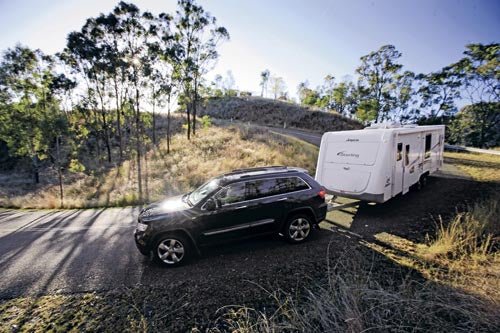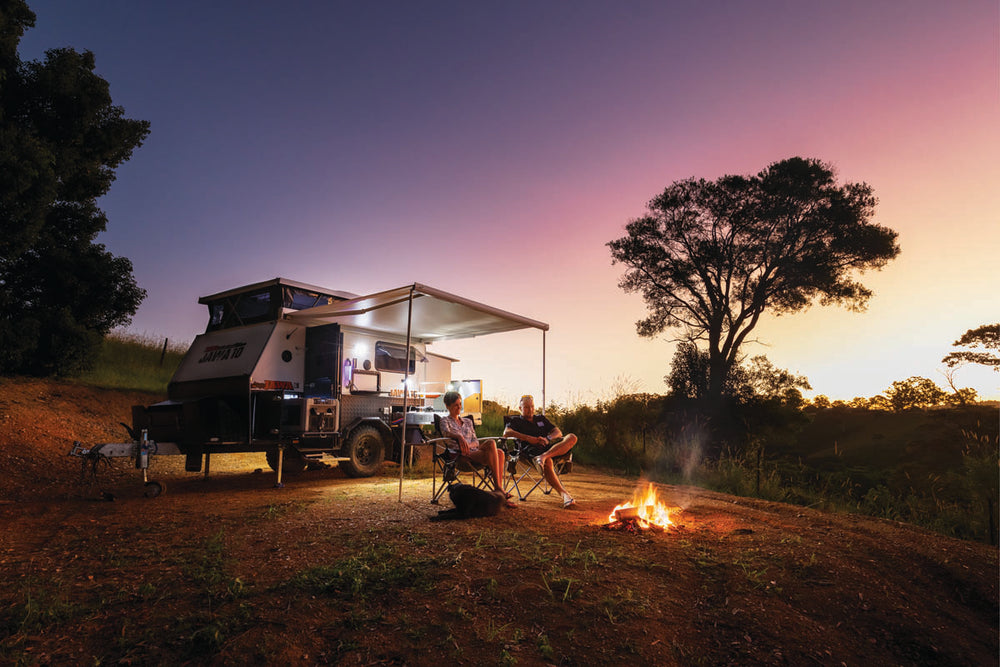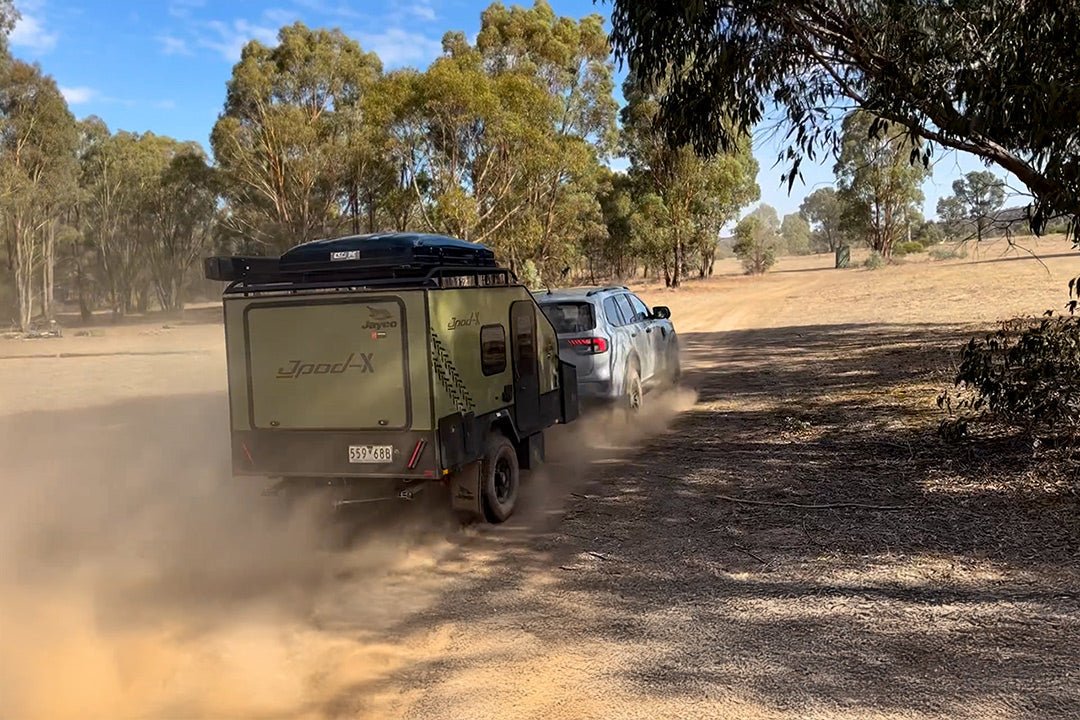Towing safety

Hitching up your rig and setting off into the sunset with miles of sunburnt land ahead is one of the great Australian dreams. But setting up and towing a van/vehicle combination requires some skill that should, for the safety of yourself and other road users, be mastered before you hit the highway.
Top 10 towing tips
1. TAKE A TOWING COURSE
It might sound a bit wimpish, not to mention a waste of money, to suggest a caravan towing course to anyone who has been driving for the last 30 years, but we beg to differ.
If you’ve been driving around in a Holden Commodore, then stepping into a 4WD tow vehicle which could weigh up to 3000kg and has a 3000kg weight swinging off the rear towbar is a wholly different prospect. Not to mention driving on rough bush tracks, reversing, braking and hitching up.
A number of tow vehicle courses offer a lot more than just reversing. Everything from safety and maintenance checks to trailer dimensions to types of hitches to pre and post-trip inspections are on the agenda. These are all items that could make or break a caravanning trip and should be considered not only from a safety point of view but also an enjoyment one.
For a couple, I believe it’s important that both husband and wife are trained in all aspects of towing. It’s not too dramatic to suggest that a potentially life threatening situation in some far flung point of Australia could be made worse by one party becoming incapacitated and the other not having the skill/knowledge to hitch/unhitch or tow a van on their own.
2. USE YOUR MIRRORS
Door-mounted mirrors are the principal means of seeing backwards when you’re towing a caravan. Rear-view cameras can be helpful, but they distort distance and the lenses get coated with road grime. Standard mirrors need to be supplemented by clip-on extensions or replacements that are wider-set than the standard peepers.
Concave ‘spotter’ mirrors aren’t as widely used but cheap, stick-on, supplementary spotters give a wider view to the side and the rear than standard mirrors. They distort distance in direct proportion to the increase in viewing area so they’re not reliable for assessing distances, but are a boon for obtaining the big picture. Spotters provide a viewing area that includes the caravan tyres, so they’re handy for checking tyre condition as you trundle along and for positioning the trailer wheels when reversing.
Many drivers have a fear of reversing caravans which usually comes from a lack of experience, so the easiest way to eradicate the fear is to practise reversing in a controlled environment – a deserted shopping centre car park is ideal.
3. CHECK YOUR BRAKES
Check your electric brake operation every day by sliding the override lever fully on after you start rolling. The van should pull up square with no sideways swing. If not, it’s time to get the brakes checked as soon as possible. There are lots of connections between your life and your brakes so a quick check might just save your life, as well as the lives of passengers and other motorists.
4. DISTRIBUTE THE WEIGHT
It’s vital that your caravan remains balanced, with the payload evenly distributed. You shouldn’t load heavy objects such as spare wheels, batteries, gas bottles and water casks in places other than those selected by the caravan maker. Heavy items have the potential to cause damage to the caravan chassis and bodywork and can cause severe loading balance problems.
Excess weight on the towball can stress the coupling and the towbar, while also overloading the towing vehicle’s rear suspension and lightening the load on the steering axle.
Too little weight on the towball can cause trailer swing and, in extreme cases, lighten the rear axle of the towing vehicle to the point where it lacks grip. Instability is certain in both these poor-loading cases.
Weight distribution hitches can be useful in shifting some ball weight to the towing vehicle’s front axle and they also reduce the pitching action of a heavy caravan, but they’re not miracle workers. Relying on torsion bars to counter excessive ball weight can lead to failure of the towbar attachment to the towing vehicle, or chassis damage.
5. MATCH THE CARAVAN AND TOW VEHICLE
The mass of the tow vehicle needs to be enough to manage the weight of the caravan. A light tow vehicle will be pushed around by a van that begins to sway. There needs to be enough traction with the road for the tow unit to control the van, and this comes about, in part, through the weight of the tow vehicle. So, heavy vans require a heavy tow vehicle for control.
6. THINK ABOUT TYRE PRESSURE
Tyres that are under-inflated create at least two towing risks. They run hotter, and so are more likely to suffer a blowout, and because the walls will tend to roll sideways with too little pressure, that can give rise to sway.
Sway is one of the most dangerous phenomena a caravanner will encounter because the van may propel a lighter-weight tow vehicle into an overturn situation.
7. LEARN TO BACK UP
Reversing a rig can be the most stressful part of caravanning, but there are ways to do it without getting into strife. Always try to angle the vehicle and van roughly where you want the van to go while still rolling forwards. In other words, while driving forwards past the point where you want the van to go, turn the vehicle to the same side as you want the van to head. This gets the vehicle and van in an open ‘V’ shape, in effect starting the turn you want when reversing. Then it’s a matter of remembering to turn the wheel the opposite way you want the van to go and slowly creeping backwards. Often people reverse too quickly – but the slower the better, with as little steering input as possible. Pull the rig forward a bit and try again if you get the angles wrong.
If you have a spotter, get them to use hand signals you’ve already agreed on so there’s less opportunity for misunderstanding. Otherwise, get out and check what’s behind you, and above your van, several times, if necessary.
Read our essential guide to reversing.
8. MASTER CUTTING IN
This one probably rates second after reversing on the caravanner’s list of nervous moments – when turning a corner, the caravan will take a shorter path around the corner than the vehicle – ‘cutting in’. This can be countered by taking the widest path possible around the corner.
You begin by moving your rig as close as you can to your side of the centre line (of a two-lane road) before the turn and turning as late as possible and as wide as possible. You soon develop a feel for it, and you realise that at times, such as on narrow suburban roads, the only way you will make the corner is to use both sides of the road. In such cases, you have to simply stop and wait until the oncoming vehicles have passed. If the combined length of your rig is long enough (more than 7.5m), you can affix a sign to the rear advising other vehicles not to overtake while you are turning, which legally allows you to straddle two lanes on a multi-lane road just prior to a turn to reduce cutting in.
Roundabouts also require a different steering technique when towing – by turning later than you normally would, you allow room for the van to stay in the lane.
9. KEEP IT SMOOTH
Anticipation is the key to smooth caravan towing. In towns, a red light is a potential green one and, more significantly, a green one is a potential red one. Your aim should be to keep moving, by easing off the accelerator on the approach to a red light, anticipating the change to green. Don’t race towards a green light and then have to brake suddenly when it changes to orange.
Hill starts take time when you’re towing, so you can avoid them sometimes by trickling slowly up a hill (within reason), rather than sitting on the tail of the vehicle in front. With some luck, the red light at the crest will change to green before you get to the tail of the traffic column.
Smoothness is vital on the open road as well, letting you maintain a steady speed with a minimum of braking and hard acceleration.
Overtaking other vehicles when towing is a much slower operation than when you’re running solo. Allow plenty of time for your journey, so you’re not pressured into risky overtaking manoeuvres.
Most people towing caravans don’t run as fast as truckies, who are used to the road and have time pressures on them. Leave your ego at home and let the trucks go by. On an uphill section that slows a truck which has already overtaken you, don’t overtake even if you can because you’ll have him back on your tail when the road levels out again. Just tuck in behind him on the hill and enjoy the scenery.
When running off hills, use the gears and engine braking to control your speed, even in an automatic. You’ll reduce brake wear in the process.
10. WORK AS A TEAM
Familiarise yourself with the van or trailer and learn how to hitch and unhitch. Create a routine when hooking the rig to the car and follow it. This will decrease the chances of missing something vital. Always get the other person to double check – the key to a successful and enjoyable trip is teamwork. The task of parking can be challenging, especially when you’re manoeuvring into a tight spot. The use of hand signals is better than yelling and screaming – and more beneficial for a long-term relationship. Always put on the handbrake before getting out of the car to unhitch. Communication is key during this process because a mistake can have fatal consequences. In a nutshell, stress-free towing comes down to lots of common sense and excellent communication.
Buying a new tow vehicle? Check out caravans for sale on TradeRVs.com.au.
Looking for somewhere to park your caravan? Check out turu.com.au for caravan parks and camping grounds.







